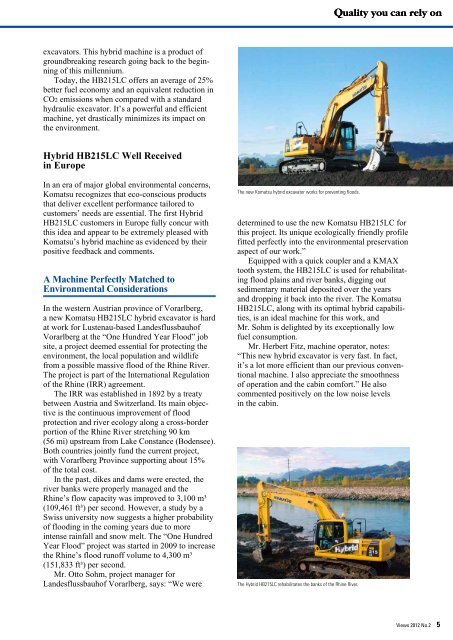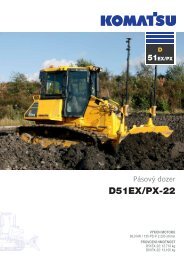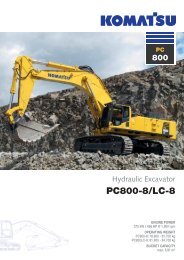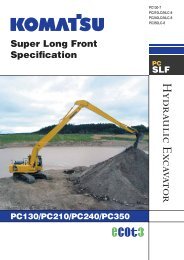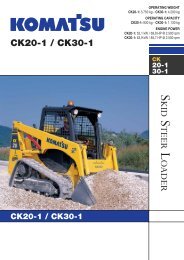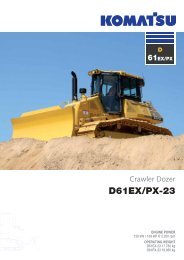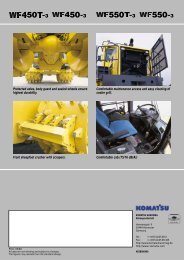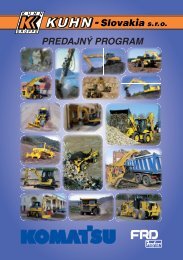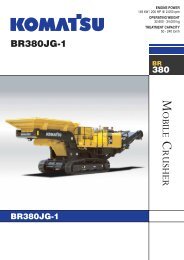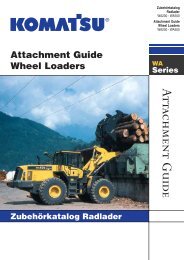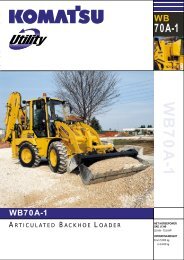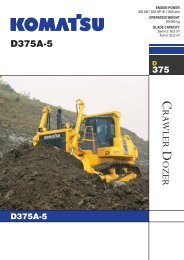Komatsu VIEWS - Komatsu America Corp.
Komatsu VIEWS - Komatsu America Corp.
Komatsu VIEWS - Komatsu America Corp.
You also want an ePaper? Increase the reach of your titles
YUMPU automatically turns print PDFs into web optimized ePapers that Google loves.
excavators. This hybrid machine is a product of<br />
groundbreaking research going back to the beginning<br />
of this millennium.<br />
Today, the HB215LC offers an average of 25%<br />
better fuel economy and an equivalent reduction in<br />
CO2 emissions when compared with a standard<br />
hydraulic excavator. It’s a powerful and efficient<br />
machine, yet drastically minimizes its impact on<br />
the environment.<br />
Hybrid HB215LC Well Received<br />
in Europe<br />
In an era of major global environmental concerns,<br />
<strong>Komatsu</strong> recognizes that eco-conscious products<br />
that deliver excellent performance tailored to<br />
customers’ needs are essential. The first Hybrid<br />
HB215LC customers in Europe fully concur with<br />
this idea and appear to be extremely pleased with<br />
<strong>Komatsu</strong>’s hybrid machine as evidenced by their<br />
positive feedback and comments.<br />
A Machine Perfectly Matched to<br />
Environmental Considerations<br />
In the western Austrian province of Vorarlberg,<br />
a new <strong>Komatsu</strong> HB215LC hybrid excavator is hard<br />
at work for Lustenau-based Landesflussbauhof<br />
Vorarlberg at the “One Hundred Year Flood” job<br />
site, a project deemed essential for protecting the<br />
environment, the local population and wildlife<br />
from a possible massive flood of the Rhine River.<br />
The project is part of the International Regulation<br />
of the Rhine (IRR) agreement.<br />
The IRR was established in 1892 by a treaty<br />
between Austria and Switzerland. Its main objective<br />
is the continuous improvement of flood<br />
protection and river ecology along a cross-border<br />
portion of the Rhine River stretching 90 km<br />
(56 mi) upstream from Lake Constance (Bodensee).<br />
Both countries jointly fund the current project,<br />
with Vorarlberg Province supporting about 15%<br />
of the total cost.<br />
In the past, dikes and dams were erected, the<br />
river banks were properly managed and the<br />
Rhine’s flow capacity was improved to 3,100 m³<br />
(109,461 ft³) per second. However, a study by a<br />
Swiss university now suggests a higher probability<br />
of flooding in the coming years due to more<br />
intense rainfall and snow melt. The “One Hundred<br />
Year Flood” project was started in 2009 to increase<br />
the Rhine’s flood runoff volume to 4,300 m³<br />
(151,833 ft³) per second.<br />
Mr. Otto Sohm, project manager for<br />
Landesflussbauhof Vorarlberg, says: “We were<br />
The new <strong>Komatsu</strong> hybrid excavator works for preventing floods.<br />
determined to use the new <strong>Komatsu</strong> HB215LC for<br />
this project. Its unique ecologically friendly profile<br />
fitted perfectly into the environmental preservation<br />
aspect of our work.”<br />
Equipped with a quick coupler and a KMAX<br />
tooth system, the HB215LC is used for rehabilitating<br />
flood plains and river banks, digging out<br />
sedimentary material deposited over the years<br />
and dropping it back into the river. The <strong>Komatsu</strong><br />
HB215LC, along with its optimal hybrid capabilities,<br />
is an ideal machine for this work, and<br />
Mr. Sohm is delighted by its exceptionally low<br />
fuel consumption.<br />
Mr. Herbert Fitz, machine operator, notes:<br />
“This new hybrid excavator is very fast. In fact,<br />
it’s a lot more efficient than our previous conventional<br />
machine. I also appreciate the smoothness<br />
of operation and the cabin comfort.” He also<br />
commented positively on the low noise levels<br />
in the cabin.<br />
The Hybrid HB215LC rehabilitates the banks of the Rhine River.<br />
Views 2012 No.2 5


